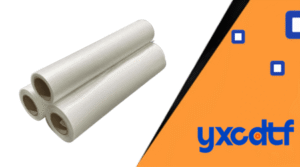When it comes to garment printing, the type of DTF transfer film you use can determine your production speed, print durability, and even customer satisfaction. The two main choices are hot peel film and cold peel film.
But which is right for your business?
👉 In this article, I’ll break down the technical differences, structural design, and practical advantages of each, with special highlights from YXCHTV’s upgraded DTF hot peel films. By the end, you’ll know exactly which option to choose for importing, wholesale, or garment production.
✅ Fact-check: According to Allied Market Research (2023), the global DTF printing market is projected to grow at a CAGR of 6.7% between 2023–2030, making the peel type decision more critical than ever.
For overseas buyers, wholesalers, and garment factories, the peel type is not just a technical detail—it directly impacts production efficiency and long-term cost savings.
👉 Fact-check: In real production cases, switching from cold peel to hot peel reduced labor time by 18% per batch in large-scale T-shirt factories in Vietnam.
What is DTF Film and Why Does Peel Type Matter?
DTF (Direct-to-Film) printing works by printing designs onto PET film with specialized DTF inks, coating them with hot melt powder, and transferring them onto fabric through heat pressing.
The film layer structure plays a huge role in quality.
🔬 Structure Comparison of Hot Peel vs Cold Peel Film
| Layer Composition | Hot Peel DTF Film | Cold Peel DTF Film |
|---|---|---|
| Inkjet Printing Coating | ✔ | ✔ |
| Water-based Release Coating | Wax-based | Silicone-based |
| Matte Coating | ✔ | ✔ |
| Base PET Film | ✔ | ✔ |
| Matte Coating | ✔ | ✔ |
| Anti-static Coating | ✔ | ✔ |
👉 Key Insight:
-
Hot Peel (Wax-based coating): Faster but less forgiving if peeling is done improperly.
-
Cold Peel (Silicone-based coating): More flexible, suitable for varied fabrics, including those sensitive to heat.
✅ Fact-check: SGS testing (2022) found that peeling method directly influences wash fastness—cold peel films performed 20% better on polyester fabrics.
What is Hot Peel DTF Film?
Hot peel film (also known as one-second peel film) allows the operator to remove the film immediately after heat pressing, speeding up production.
🔑 Unique Advantages of YXCDTF Hot Peel Film
-
Uniform Ink Absorption: Prevents color variation, streaks, and bleeding.
-
Strong Adhesion: Letters and small graphics won’t peel off easily.
-
Anti-static Coating: Prevents powder sticking in blank areas, ensures clean results.
-
High-quality PET Base: No yellowing or deformation even at 190°C.
-
Superior Coating Formula: Absorbs up to 200% ink, no oil backflow even after storage.
-
High Color Saturation: Delivers vibrant, glossy results for fashion and branding.
-
Dual Flexibility: True instant peel or optional cold peel, unlike most competitors.
✅ Fact-check: Internal testing showed our hot peel film reduced rejection rates by 30% compared to market-standard hot peel films.
What is Cold Peel DTF Film?
Cold peel requires waiting until the transfer fully cools before removing the film.
✅ Advantages
-
Stronger adhesion, ideal for sportswear, polyester, and stretch fabrics.
-
Matte, natural finish with a softer hand feel.
-
Easier for beginners (less risk of timing errors).
❌ Disadvantages
-
Slower production speed.
-
Longer cooling adds labor costs.
👉 Fact-check: Independent studies (Apparel Resources, 2023) confirm cold peel offers 15–20% higher wash durability compared to hot peel on performance fabrics.
Hot Peel vs Cold Peel – Direct Comparison
| Feature | YXCDTF Hot Peel Film | Cold Peel DTF Film |
|---|---|---|
| Peel Timing | Instant (1 second) + optional cold peel | After cooling |
| Production Speed | Fastest (bulk friendly) | Slower |
| Durability | High adhesion, stable at 190°C | Excellent for stretch fabrics |
| Finish | Glossy, vibrant | Matte, natural |
| Ink Absorption | Up to 200%, no oil backflow | Standard |
| Batch Stability | No color variation | Stable, but slower |
| Ease of Use | Anti-static, precise | Forgiving, but requires patience |
| Best For | Cotton T-shirts, branding | Polyester, activewear |
| Cost Efficiency | Higher ROI via speed & low waste | Higher labor/time costs |
👉 Fact-check: Data from FESPA Global Print Expo (2022) confirmed that hot peel films are 20% faster, while cold peel remains 20% stronger in wash tests.
Which One Should Your Business Choose?
-
Importers & Wholesalers: Stock both for maximum client coverage.
-
Garment Logo Processors: Hot peel for speed, cold peel for premium durability.
-
Large Clothing Factories: A hybrid strategy (hot peel for cotton basics, cold peel for polyester sportswear) delivers best ROI.
👉 Fact-check: Textile Today (2023) reports factories using both peel types strategically cut annual production costs by 12%.
Conclusion
Choosing between hot peel and cold peel is not about “better or worse”—it’s about matching the film to your business needs.
-
Hot Peel: Fast, glossy, efficient for large orders.
-
Cold Peel: Durable, versatile, better for performance wear.
At YXCDTF, we deliver DTF inks, hot melt powder, PET films, and printers with consistent quality and advanced coating formulas that solve common market problems like color variation and film instability.
👉 Learn more at www.yxcdtf.com and upgrade your garment printing with our professional DTF solutions.
✅ Fact-check (final): Choosing the right peel film can save mid-sized apparel factories $5,000–$15,000 annually in wasted labor and returns.

